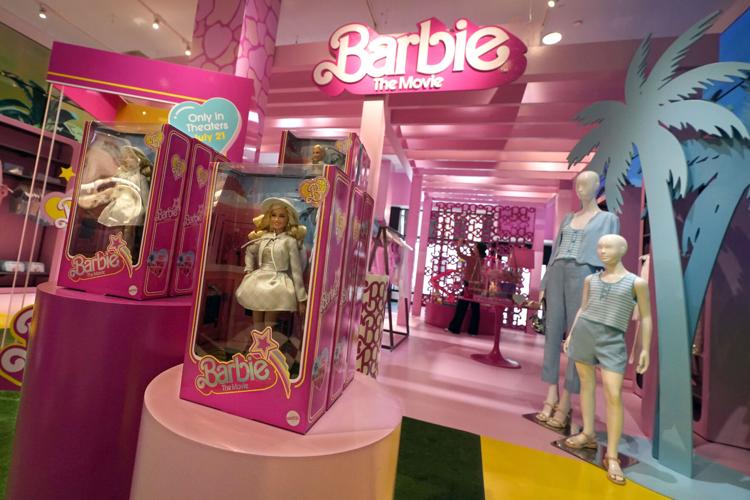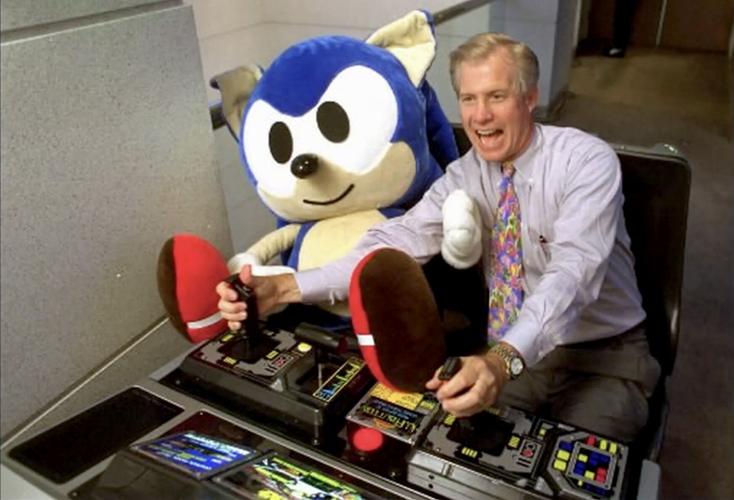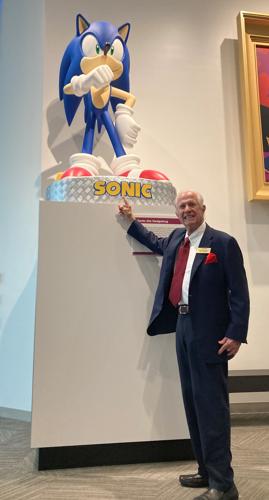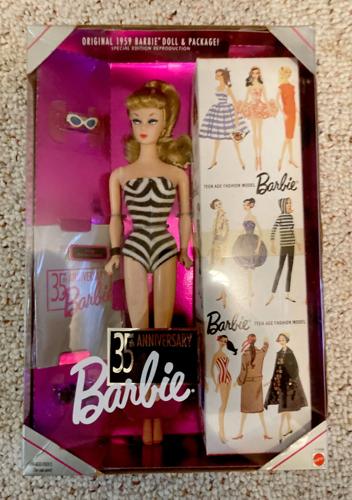This summer’s box office smash “Barbie” has so far made $1.44 billion in global ticket sales, landing it at No. 14 on the list of highest grossing movies of all time and the highest ranking female-dominated film.
Barbie fans can thank former Tucsonan Thomas Kalinske.
Back in 1973, Kalinske saved Barbie.
He also was behind the launch of He-Man Masters of the Universe and later helped Sega muscle its way past Nintendo in the early ‘90s hugely competitive video gaming industry.
But his most enduring achievement was rescuing Barbie in 1973 against all odds.
To understand how Tom Kalinske saved Barbie, you need to go back to Tucson, early 1950s.
Toys and the Tucson Boys Chorus
Kalinske and his family had relocated to Tucson from his parents’ native Wisconsin in 1950 for his father’s job. His mom was a homemaker and artist and Kalinske, his big brother and two sisters went to school at Robinson Elementary not far from their house on Devon Drive.
Kalinske didn’t have a lot of toys growing up.
“I had little green diecast soldiers and gray diecast metal soldiers,” he recalled, but he was a big fan of Dinky cars, the British precursor to America’s Hot Wheels and Matchbox cars.
Every month, he would wander over to the drug store in nearby Broadway Village to check out their new shipment of toys.
“I would wait to see if there was a Dinky car I didn’t have yet, and often there was, and for 50 cents I would buy it,” he recalled.
That was about the extent of his toy fascination. He spent most of his time from 12 on performing with the Tucson Boys Chorus. His mom knew he enjoyed singing so she forced him, he said, to audition.
He must have impressed the directors because almost immediately, he recalled, he went into the travel group. For six years, through his first couple of years at Tucson High, he traveled the country and abroad with the chorus, performing twice on the “Ed Sullivan Show” and touring Australia, where the Boys Chorus was drawing bigger audiences than Bob Hope. During his tenure, the chorus released “Melody at Sunset” and “Campfire Songs” on Capital Records.
“The Tucson Boys Chorus had a big influence on me,” said the 79-year-old father of six. “Being able to perform around the country and the world. I also was the president of the chorus and the emcee so I had to stand up and explain what we were going to do at various points in the concert. You had to build some self-confidence to do that and you had to work with all kinds of different kids.”
After he graduated from Tucson High, he went to his parents’ alma mater, University of Wisconsin, for his undergrad degree then came home to Tucson. The Vietnam War was starting and Kalinske got drafted so he drove home and signed on with an Army Tank Division stationed in Tucson that focused on desert warfare. He figured serving in a unit that trained for desert warfare pretty much guaranteed he wouldn’t be sent to fight in Vietnam.
After the military, he earned his MBA from the University of Arizona and set out to make a name for himself. His advisors were pushing him to join GE or another big corporation, but Kalinske wanted to do something that involved marketing.
That’s how he landed at J. Walter Thompson in New York, the seminal advertising agency that focused on marketing and product development.
Along came Fred Flintstone
At J. Walter, Kalinske worked on everything from Chun King Egg Rolls to Jeno’s Pizza Rolls, but his big break came when he joined the team working with Miles Laboratories, makers of One-A-Day Vitamins, Alka-Seltzer and a children’s chewable vitamin called Chocks.
When Miles Labs competitor, Bristol Myers, introduced its fruity, fun-shaped children’s vitamins, Chocks “literally disappeared off the face of the Earth. You’ve never seen a decline that fast,” Kalinske said.
Miles wanted J. Walter to develop a new children’s vitamin that could compete with Bristol Myers. At the time, the Hanna-Barbera cartoon “The Flintstones” was airing on ABC on Friday nights and had a commanding national audience. That inspired Kalinske and his team to pitch a children’s vitamin based on the Flintstones’ characters.
When they arrived in Miles Labs’ Elkhard, Indiana, headquarters to pitch the plan, they were shot down. Miles officials believed the show’s move to the Saturday morning cartoon lineup for kids would be a detriment.
“So we went back, did more research, came back and said, ‘It’s better that it’s on children’s time. The kids want it, too. Besides the moms wanting it, the kids want it,’” Kalinske and the team argued.
Miles hemmed and hawed before finally agreeing, on the condition that Kalinske come to Indiana and work with the team developing the product. While the nutritionists created the vitamins, Kalinske created the marketing plan, from the packaging to the slogans. His plan also included the first-ever children’s commercial featuring Rotoscope animation, where live action is filmed against a green screen and animation is added. The commercial showed a kid climbing a steep hill with Fred Flintstone and Barney Rubble singing “Yabba dabba do, yabba dabba do, Flintstones vitamins are good to chew.”
The product was an instant success.
“Flintstone Vitamins took off in sales like you’ve never seen,” Kalinske said. “As fast as Chocks went down, Flintstones went up. It became the No. 1 chewable children’s vitamin in 1969 and I believe it still is today.”
Flintstones also opened the Mattel door for Kalinske.
Barbie is calling
That chapter began in the hallowed halls of the U.S. Senate, which was holding hearings on advertising aimed at children, from cereal manufacturers to candy companies, toy manufacturers and, quite oddly, the marketing for Flintstones Vitamins for Kids.
Kalinske was called to testify on behalf of Miles Laboratories and J. Walter. Sen. Margaret Chase Smith from Maine pointed her finger at him and accused him of selling drugs to children. Kalinske quickly corrected her, clarifying that the chewable vitamins were not a drug but a nutritional product that moms loved because they were giving their children needed vitamins. He then read a letter from a mom attesting to everything he had told Smith and the subcommittee.
“I pulled out a mailbag and I said, ‘I have 500 more letters. Can I read some more to you?’ She said, ‘That will be enough, Mr. Kalinske’ and she didn’t ask me another question,” he said, laughing at the memory.
The guys from Mattel, who were also called to testify, were sitting behind him and in the hall later, they told him that they liked his act. They suggested he come out to California to interview for a job.
That’s how he landed in a cubicle at Mattel’s headquarters in 1972.
She’ll outlive us all

To celebrate Barbie’s 35th anniversary, Mattel introduced a redo of the original doll in her striped bathing suit.
Kalinske remembers that he didn’t have an office when he first arrived at Mattel. He had a cubicle where he quickly started to make a name for himself as the product manager for Mattel’s preschool toys including See ‘N Say, Jack-In-the-Box and Putt Putt Railroad. He also helped expand the Tuff Stuff line of unbreakable plastic toys, which helped grow the line from a $10 million a year business to $80 million.
One day in 1973, Mattel founder and Barbie’s creator Ruth Handler wandered over to Kalinske’s cubicle. She told him that sales of Barbie had tanked from $100 million a year to $42 million and market analysts, retailers and Wall Street were all predicting the doll’s demise.
Kalinske’s response: “Barbie will be around long after you and I are gone.”
When Handler told him she was going to get him assigned to the Barbie line, he asked her: “‘What makes Barbie so special to you’ aside from the fact that it was named after her daughter,” he recalled during a phone call from his Northern California home.
“She said, ‘Well, with Barbie a girl could be anything she wants to be.’ And I used those words for the next 15 years on every package and in every commercial and every PR pitch … to facilitate that brand strategy,” he said.
Kalinske’s approach included repackaging Barbie in all pink, instead of the multicolor packaging they were using.
“I remember the president at the time came to me: ‘You mean even Ken is going to be in pink packaging?’ And I said, ‘Yep, even Ken,’” he said.
He also changed the way they introduced new additions to the Barbie lineup. Before, Mattel would add a new friend for Barbie or accessories once or twice a year. He decided to expand that to include accessories and products based on everything from price point to hair colors to age groups. He introduced My First Barbie aimed at girls as young as 3 and expanded the occupational Barbie line, which eventually came to encompass 250 careers, from the inaugural astronaut Barbie to doctor, teacher, firefighter, scientist and engineer.
“I would do a low-priced accessory for Barbie, like a bicycle, and then a mid-priced one like a car, a new Ferrari or Corvette,” he said.
He also introduced the high-priced Barbie house, which took up lots of shelf space at retail and spurred spinoff products including furniture and friends to fill the house. And everything was marketed under the slogan “Hey Girl, with Barbie you can be anything you want to be.”
Within a few years, Barbie sales skyrocketed to $500 million.
Kalinske went on to become Mattel’s vice president of product development, which led to the He-Man and Masters of the Universe launch that became a $750 million brand, before becoming CEO.
He left the company in 1987 and joined Mattel’s toy car competitor Universal Matchbox, based in London. Under his three-year leadership there, the company grew from losing some $50 million a year to making $350 million.
Next stop: Sega

Thomas Kalinske was president of Sega of America in the 1990s.
Kalinske was on a beach in Hawaii when he saw Sega President Hayao Nakayama walking toward him.
He asked Nakayama what had brought him from Tokyo to Hawaii.
You, he replied.
“I want you to come to Tokyo. I have something to show you,” he told Kalinske.
It was mid-1990 and Sega was struggling for dominance in the home gaming console market. Nakayama told Kalinske he believed Sega’s more powerful 16-bit Genesis operating system was far superior to Nintendo’s 8-bit NES technology. He just needed someone like Kalinske to tell the world.
Kalinske signed on as Sega’s CEO and developed a multipronged strategy to take on Nintendo that started with dropping the price of the console and marketing it to older teens and young adults rather than chasing Nintendo’s younger market demographic.
He also developed anti-Nintendo attack ads including the famous Sega scream and in 1991, heralded the arrival of Sonic the Hedgehog, developed in-house, as Sega’s mascot to compete with Nintendo’s Mario Brothers.
By 1993, Sega outpaced Nintendo in market share largely on the back of Sonic the Hedgehog. Since its release, sales of the game and related merchandise has topped $12 billion to date. In the first quarter of 2023, Sega reported moving 1.6 billion Sonic units triggered by renewed attention to the game from the 2020 release of the movie “Sonic the Hedgehog” and the 2022 release of the sequel, “Sonic the Hedgehog 2,” according to company reports.
Kalinske’s Sega journey was chronicled in the book and documentary “Console Wars.”
Journey’s not over

Thomas Kalinske at the Strong National museum of Play in Rochester, N.Y.
Thomas Kalinske tries to get home to Tucson every year to visit his big brother Bob, a retired physician 10 years Kalinske’s senior.
“He lives on the golf course in SaddleBrooke,” Kalinske said, and when he gets the chance, Kalinske likes to take in a few holes on the lush far north Tucson course.
Kalinske no longer works full-time; he survived a massive stroke four years ago and a follow up minor stroke a couple years ago and is following his doctor’s orders to slow down.
But he’s not done making a mark in the toy world.
After he left Sega, Kalinske became CEO and chairman of Leapfrog, which was a startup when he joined. Under his leadership, the company, which specialized in hand-held preschool video games to teach kids colors, numbers and letters, became the largest educational toy company in the U.S. with revenues topping $600 million.
“I’ve loved my career, especially my time at Mattel and Sega,” he said. “Sega stands out as the team (that) I worked with that changed the video game industry from a $3.5 billion kids business to a $250 billion market played by all ages.”
The U.S. video game market is now bigger than the movie and music industries combined.
As for Barbie: Mattel reported third-quarter sales of $1.92 billion, largely driven by global sales of Barbie, according to Fortune.








